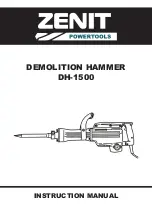
10
| English
2 609 932 855 | (26.11.12)
Bosch Power Tools
Safety Warnings for Jigsaws
Hold power tool by insulated gripping surfaces, when
performing an operation where the cutting accessory
may contact hidden wiring or its own cord.
Cutting ac-
cessory contacting a “live” wire may make exposed metal
parts of the power tool “live” and could give the operator an
electric shock.
Additional Safety and Working
Instructions
Keep hands away from the sawing range. Do not reach
under the workpiece.
Contact with the saw blade can
lead to injuries.
Apply the machine to the workpiece only when
switched on.
Otherwise there is danger of kickback when
the cutting tool jams in the workpiece.
Pay attention that the base plate rests securely on the
material while sawing.
A jammed saw blade can break or
lead to kickback.
When the cut is completed, switch off the machine and
then pull the saw blade out of the cut only after it has
come to a standstill.
In this manner you can avoid kick-
back and can place down the machine securely.
Use only undamaged saw blades that are in perfect con-
dition.
Bent or dull saw blades can break, negatively influ-
ence the cut, or lead to kickback.
Do not brake the saw blade to a stop by applying side
pressure after switching off.
The saw blade can be dam-
aged, break or cause kickback.
Use suitable detectors to determine if utility lines are
hidden in the work area or call the local utility company
for assistance.
Contact with electric lines can lead to fire
and electric shock. Damaging a gas line can lead to explo-
sion. Penetrating a water line causes property damage or
may cause an electric shock.
Secure the workpiece.
A workpiece clamped with clamp-
ing devices or in a vice is held more secure than by hand.
Always wait until the machine has come to a complete
stop before placing it down.
The tool insert can jam and
lead to loss of control over the power tool.
Before any work on the machine itself, pull the mains
plug.
Do not direct the light beam at persons or animals and
do not stare into the light beam yourself (not even from
a distance).
Check the tight seating of the saw blade.
A loose saw
blade can fall out and lead to injuries.
The saw blade should not be longer than required for
the intended cut. Use a narrow saw blade when sawing
tight curves.
When ejecting the saw blade, hold the machine in such
a manner that no persons or animals can be injured by
the ejected saw blade.
Dusts from materials such as lead-containing coatings,
some wood types, minerals and metal can be harmful to
one’s health and cause allergic reactions, lead to res-
piratory infections and/or cancer.
Materials containing
asbestos may only be worked by specialists.
–
As far as possible, use a dust extraction system suitable
for the material.
–
Provide for good ventilation of the working place.
–
It is recommended to wear a P2 filter-class respirator.
Observe the relevant regulations in your country for the
materials to be worked.
Prevent dust accumulation at the workplace.
Dusts can
easily ignite.
Observe correct mains voltage! The voltage of the pow-
er source must agree with the voltage specified on the
nameplate of the machine. Power tools marked with
230 V can also be operated with 220 V.
To save energy, only switch the power tool on when using
it.
The restarting protection prevents uncontrolled start-
ing of the machine after a power failure.
To restart the
machine, set the On/Off switch to the off position, and
then switch the power tool on again.
The contact protector attached to the casing (see fig-
ure 16, page 188) prevents accidental touching of the
saw blade during the working procedure and may not
be removed.
Before sawing in wood, particle boards, building mate-
rials etc., check for foreign objects, such as nails,
screws, etc. and remove them as required.
Plunge cuts may only be applied to soft materials, such
as wood, gypsum board, etc. For plunge cuts, use only
short saw blades.
The metal overshoe prevents the plastic footplate from
being scratched up, especially when sawing metal.
Adapt the settings of your power tool to the respective
application. For example, reduce the stroke rate and
orbital action when cutting metal or for tight curved
cuts.
When working small or thin work pieces, always use a
sturdy support or a saw table (accessory).
In extreme conditions, always use dust extraction as
far as possible. Blow out ventilation slots frequently
and install a residual current device (RCD).
When work-
ing metals, conductive dust can settle in the interior of the
power tool. The total insulation of the power tool can be im-
paired.
Products sold in GB only
: Your product is fitted with an
BS 1363/A approved electric plug with internal fuse (ASTA
approved to BS 1362).
If the plug is not suitable for your socket outlets, it should be
cut off and an appropriate plug fitted in its place by an author-
ised customer service agent. The replacement plug should
have the same fuse rating as the original plug.
The severed plug must be disposed of to avoid a possible
shock hazard and should never be inserted into a mains sock-
et elsewhere.
Products sold in AUS and NZ only
: Use a residual current de-
vice (RCD) with a rated residual current of 30 mA or less.
OBJ_BUCH-1320-004.book Page 10 Monday, November 26, 2012 9:56 AM
Та
ше
в
-
Га
лв
ин
г
ОО
Д
www.tashev-galving.com











































